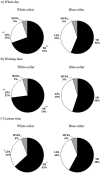Comparison of accelerometer-measured sedentary behavior, and light- and moderate-to-vigorous-intensity physical activity in white- and blue-collar workers in a Japanese manufacturing plant
- PMID: 29563367
- PMCID: PMC5985348
- DOI: 10.1539/joh.2017-0276-OA
Comparison of accelerometer-measured sedentary behavior, and light- and moderate-to-vigorous-intensity physical activity in white- and blue-collar workers in a Japanese manufacturing plant
Abstract
Objective: The times spent in sedentary behavior (SB) and moderate-to-vigorous physical activity (MVPA) are independently associated with health outcomes; however, objective data on physical activity levels including SB among different occupations is limited. We compared accelerometer-measured times spent in SB, light-intensity physical activity (LPA), and MVPA, and the patterns associated with prolonged bouts of SB between white- and blue-collar workers.
Methods: The study population consisted of 102 full-time plant workers (54 white-collar and 48 blue-collar) who wore a triaxial accelerometer during waking hours for 5 working days. Accelerometer-measured activity levels were categorized as SB (≤1.5 metabolic equivalents (METs)), LPA (1.6-2.9 METs), and MVPA (≥3.0 METs). A sedentary bout was defined as consecutive minutes during which the accelerometer registered less than ≤1.5 METs. Accelerometer variables were compared between white- and blue-collar workers through analysis of covariance.
Results: During working hours, white-collar workers spent significantly more time in SB and less time in LPA than blue-collar workers (SB: 6.4 h vs. 4.8 h, 73% vs. 55% of total work time; LPA: 1.9 h vs. 3.5 h, 22% vs. 40% of total work time, p<.001), whereas the MVPA time was similar between the groups. White-collar workers spent significantly more SB time in prolonged sedentary bouts (≥30 min) compared to blue-collar workers. During leisure time, the SB, LPA, and MVPA times were similar between the groups.
Conclusions: White-collar workers have significantly longer SB times than blue-collar workers during work hours, and do not compensate for their excess SB during work by reducing SB during leisure time.
Keywords: Accelerometer; Occupational exposure; Physical activity; Sedentary behavior.
Conflict of interest statement
Figures


Similar articles
-
Exposure to prolonged sedentary behavior on weekdays rather than weekends in white-collar workers in comparison with blue-collar workers.J Occup Health. 2021 Jan;63(1):e12246. doi: 10.1002/1348-9585.12246. J Occup Health. 2021. PMID: 34275174 Free PMC article.
-
What Is the Effect on Obesity Indicators from Replacing Prolonged Sedentary Time with Brief Sedentary Bouts, Standing and Different Types of Physical Activity during Working Days? A Cross-Sectional Accelerometer-Based Study among Blue-Collar Workers.PLoS One. 2016 May 17;11(5):e0154935. doi: 10.1371/journal.pone.0154935. eCollection 2016. PLoS One. 2016. PMID: 27187777 Free PMC article.
-
Sedentary behaviors and physical activity of the working population measured by accelerometry: a systematic review and meta-analysis.BMC Public Health. 2024 Aug 6;24(1):2123. doi: 10.1186/s12889-024-19449-y. BMC Public Health. 2024. PMID: 39107699 Free PMC article.
-
Bidirectional associations of accelerometer-derived physical activity and stationary behavior with self-reported mental and physical health during midlife.Int J Behav Nutr Phys Act. 2021 Jun 6;18(1):74. doi: 10.1186/s12966-021-01145-4. Int J Behav Nutr Phys Act. 2021. PMID: 34090471 Free PMC article.
-
Sedentary and Physical Activity Behavior in "Blue-Collar" Workers: A Systematic Review of Accelerometer Studies.J Phys Act Health. 2019 Nov 1;16(11):1060-1069. doi: 10.1123/jpah.2018-0607. Epub 2019 Aug 29. J Phys Act Health. 2019. PMID: 31469366
Cited by
-
Can self-monitoring mobile health apps reduce sedentary behavior? A randomized controlled trial.J Occup Health. 2020 Jan;62(1):e12159. doi: 10.1002/1348-9585.12159. J Occup Health. 2020. PMID: 32845553 Free PMC article. Clinical Trial.
-
Association between sitting time at work and the onset of major depressive episode: a 1-year prospective cohort study using the Bayesian regression.BMC Public Health. 2021 Oct 29;21(1):1960. doi: 10.1186/s12889-021-12059-y. BMC Public Health. 2021. PMID: 34715837 Free PMC article.
-
Exposure to prolonged sedentary behavior on weekdays rather than weekends in white-collar workers in comparison with blue-collar workers.J Occup Health. 2021 Jan;63(1):e12246. doi: 10.1002/1348-9585.12246. J Occup Health. 2021. PMID: 34275174 Free PMC article.
-
mHealth Intervention to Promote Physical Activity Among Employees Using a Deep Learning Model for Passive Monitoring of Depression and Anxiety: Single-Arm Feasibility Trial.JMIR Form Res. 2023 Nov 17;7:e51334. doi: 10.2196/51334. JMIR Form Res. 2023. PMID: 37976094 Free PMC article.
-
Respiratory Function and Muscle Strength Vs. Past Work Type: a Cross-Sectional Study Among Retirees.Can Geriatr J. 2021 Dec 1;24(4):297-303. doi: 10.5770/cgj.24.501. eCollection 2021 Dec. Can Geriatr J. 2021. PMID: 34912483 Free PMC article.
References
-
- Tudor-Locke C, Leonardi C, Johnson WD, et al. . Time spent in physical activity and sedentary behaviors on the working day: the American time use survey. Journal of Occupational and Environmental Medicine 2011; 53 (12): 1382-1387. - PubMed
-
- Gebel K, Ding D, Chey T, et al. . Effect of Moderate to Vigorous Physical Activity on All-Cause Mortality in Middle-aged and Older Australians. JAMA Internal Medicine 2015; 175 (6): 970-977. - PubMed
-
- Samitz G, Egger M, Zwahlen M. Domains of physical activity and all-cause mortality: systematic review and dose-response meta-analysis of cohort studies. International Journal of Epidemiology 2011; 40 (5): 1382-1400. - PubMed
-
- Biswas A, Oh PI, Faulkner GE, et al. . Sedentary time and its association with risk for disease incidence, mortality, and hospitalization in adults: a systematic review and meta-analysis. Annals of Internal Medicine 2015; 162 (2): 123-132. - PubMed
Publication types
MeSH terms
LinkOut - more resources
Full Text Sources
Other Literature Sources
Medical
Miscellaneous

